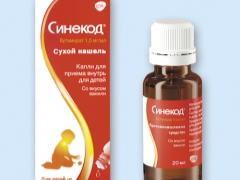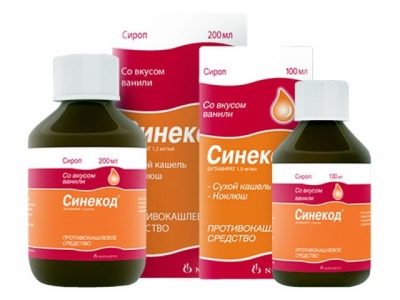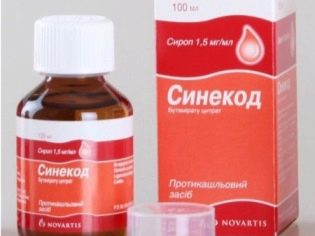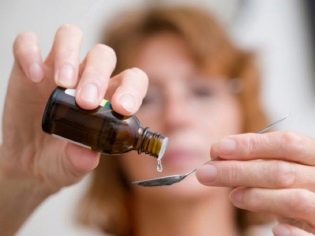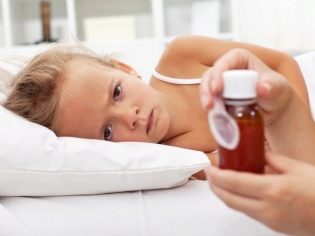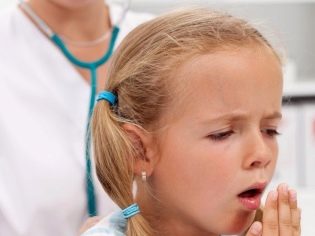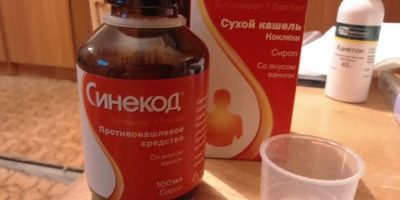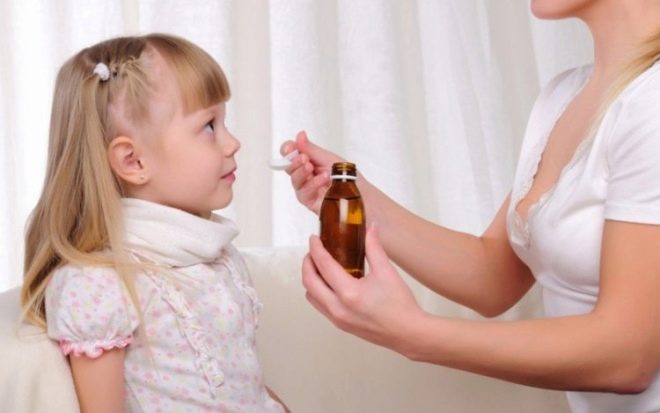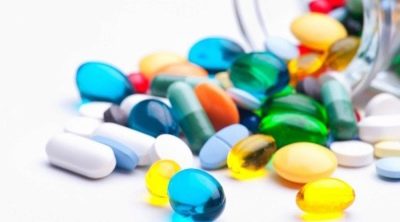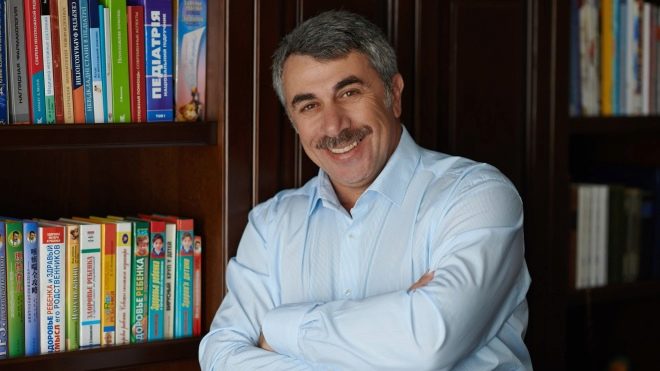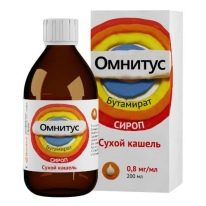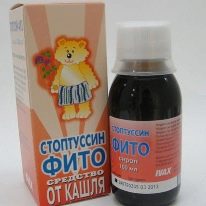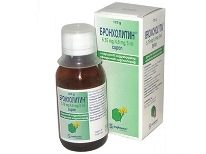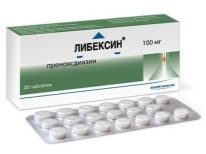Sinekod for children: instructions for use
If the child has a wet cough, he is prescribed medication that helps to quickly remove sputum from the respiratory tract. But sometimes coughing is unproductive - this is how a dry and rather painful symptom of some diseases of the respiratory tract, for example, whooping cough or laryngitis, is called. In such cases, the doctor may prescribe a drug that is able to suppress the cough reflex, for example, Sinekod.
Release form
The drug is presented in pharmacies in two options:
- Drops. This Sinekod is sold in small bottles with a dropper dispenser. Inside one such glass bottle is 20 ml of clear liquid smelling of vanilla. She often has no color, but can have a slight yellow tint.
- Syrup. This type of Synekod is also produced in glass vials, but their size is larger, because 100 or 200 ml of a clear and sweet-tasting solution can be placed in one bottle. It is colorless and also has a vanilla aroma. The dropper on the syrup vial is absent, and a measuring cap is used to dispense such a medicine, which, together with the bottle, is placed in a cardboard box.
Composition
Both types of Sinekod contain the same active substance, called butamirate. However, the amount of this compound in the form of citrate is different:
- in 1 ml of drops, its dose is 1.5 mg;
- 1 ml of syrup contains 5 mg of butamirate.
Auxiliary components of such drugs are the same and are represented by 70% sorbitol, sodium saccharinate, 96% ethanol, sodium hydroxide, glycerol, vanillin, benzoic acid and water. It turns out that the only differences in drops from syrup are the lower dosage of the active ingredient, a different volume of solvent and the name.
Operating principle
Sinekod is a group of antitussive drugs with a central action, since butamirate in its composition affects the activity of the cough center located in the brain. As a result of this overwhelming effect, the signals do not reach the bronchi, and the cough ceases. Since this tool is non-narcotic, it is permissible to use it in the fight against dry cough for quite a long time (there is no addiction to it).
The drug not only suppresses cough, but also:
- contributes to the expansion of the lumen of the bronchi (this effect is called bronchodilating);
- reduces the resistance of the respiratory tract;
- positive effect on blood saturation with oxygen.
Such effects are manifested by the relief of breathing and the acceleration of the healing process due to the elimination of oxygen starvation of the tissues.
Indications
Since Sinekod has the ability to influence the cough reflex, the main reason to prescribe such a drug to children is a painful, debilitating dry cough, in which sputum is practically not formed. Its cause is swelling, irritation and inflammation of the mucous membrane of the respiratory tract.
When information about this condition comes from the respiratory tract receptors in the brain, it is perceived as evidence of the presence of some irritating factor in the respiratory tract (for example, dust, allergen, mucus).And therefore, the command to stimulate cough comes to the cough center so that the irritating object is removed.
If sputum really was the cause, then after coughing, the brain would receive new information about its absence, after which the command would be given to stop activating the cough reflex. However, with a dry cough, there is no factor that could be removed by coughing.
For this reason, the receptors in the airways continue to give signals that are perceived by the brain as the need for new attempts to remove the irritant. As a result, the cough does not stop and continues to torment the patient, not bringing relief. In such situations it is required to block the cough reflex, with which Sinekod copes.
The use of medication for the night improves the sleep of the child, as it relieves night cough.
The drug is prescribed for:
- whooping cough;
- pleurisy;
- laryngitis;
- pharyngitis;
- bronchial asthma;
- laryngotracheitis;
- chronic bronchitis;
- tracheitis;
- tracheobronchitis;
- bronchopneumonia;
- emphysema;
- the need to conduct bronchoscopy or other manipulation of the bronchi.
The drug can be taken with acute respiratory viral infections or a cold, if the disease manifests itself only with a dry, painful cough, but as soon as sputum begins to form and the cough becomes wet, Sinekod will immediately stop taking it.
From what age can I give?
The synecod is administered in drops, even for infants, since this medicine can be used from 2 months of age. This is due to the non-narcotic nature of the drug and the minimum frequency of side effects from its use. However, the relative safety of Sinekod should in no case be a reason to give a drop without a doctor's prescription.
Besides it is forbidden to exceed the dosage prescribed by the doctor, because in childhood, even a small overdose can adversely affect the condition of a small patient. As for the syrup, due to the higher concentration of butamirate, this form of Sinekod is given from 3 years of age.
Contraindications
Sinekodom treatment is prohibited in case of hypersensitivity to any of the components of the selected medication. The drug is also not prescribed for diseases of the respiratory system with a significant release of sputum (if productive cough) and obstructive syndrome.
Side effects
The use of Sinekod in rare cases causes:
- nausea;
- skin rashes;
- diarrhea;
- dizziness;
- drowsiness.
Instructions for use
Sinekod should be drunk before eating, be sure to shake the bottle before use so that the contents mix well. Using syrup, it is necessary to remove the measuring cap from the box and dial the solution to the desired division, and then give the child to drink it directly from the cap.
After swallowing the syrup, the patient can drink it with water. Next, the cap should be washed and stored after drying, together with the bottle until the next reception.
If the child needs to be given drops, a small container or a clean spoon is required. Turning the vial over such a container or spoon, measure the required number of drops and allow them to be swallowed, after which you can give a little water to the crumbs.
Drops give four times a day in a single dose:
- 10 drops to a child under one year old;
- 15 drops to a child 1-3 years old;
- 25 drops to a child over 3 years old.
Syrup is administered to children three times a day in such a single dosage:
- 5 ml baby 3-5 years;
- 10 ml to the child of 6-11 years;
- 15 ml patient 12 years and older.
It is important to ensure that the little patient drinks the medication at the correct dose. If the baby spits out drops or syrup, it is not necessary to give the medicine again, because you can accidentally exceed the dosage. It is best to wait for the time of the next dose and give Sinekod in full dose.
The duration of the drug should be determined by the doctor, but Sinekod not advised to drink more than 7 days in a row. If during this time the cough has not passed, a second consultation with a doctor is required.
Overdose
Due to the accidental intake of a too high dose of Sinekod, a child may experience nausea, dizziness, or drowsiness. An excess amount of medication can also cause diarrhea, vomiting, or a decrease in blood pressure. In such a situation, it is recommended to wash the stomach and give the patient a sorbent.
Interaction with other drugs
Since the use of Sinekod suppresses cough, this drug should not be given simultaneously with drugs that are referred to as mucolytics and expectorant drugs. Joint administration of these medications can cause accumulation of liquid sputum in the airways, which will increase the risk of bronchospasm and secondary infection.
With drugs from other groups, for example, with Erespalo, Azithromycin, Macropene and other drugs prescribed for diseases of the respiratory system, the use of synecode is allowed.
Terms of sale
Both forms of Sinekod are classified as over-the-counter medicines, so they can be easily purchased at most pharmacies. The average cost of 100 ml of syrup is 200 rubles, and one bottle of drops costs about 350 rubles.
Storage conditions
You can keep the Sinekod at home at a temperature not higher than 30 degrees Celsius by placing the vial of drops or syrup out of the reach of children. The shelf life of such a drug is quite large and is 5 years.
The opened drug does not deteriorate, so its shelf life after the first use is not reduced.
Reviews
According to parents, Sinekod is a fairly effective medicine that helps with barking and dry cough. According to mothers, the use of such a drug eased the condition of a child with whooping cough, tracheitis, laryngitis and other diseases.
Drops praise for the ability to give babies, ease of use and sweet taste, and the main disadvantage of this form is called the high cost. The advantages of syrup include its effectiveness and a more affordable price, but many children do not like the taste of such Sinekod.
Doctors speak about this drug mostly positively. Dr. Komarovsky considers it an effective tool, but does not recommend using it without a doctor's prescription.Indeed, in some cases, its use can harm and worsen the condition of a small patient.
Analogs
Instead of Sinekod, the doctor may recommend drugs with similar therapeutic effects:
- Codelac Neo. The active component of this medicine is butamirate too. Such a medicine, like Sinekod, is represented by vanilla syrup and droplets with the smell of vanilla, but they are cheaper. The drug is in demand for dry cough and in the form of drops can also be used from two months of age, and syrup is given to patients older than 3 years. There are also tablets Codelac Neo, but their children are not prescribed.
- Omnitus. This is another analogue of Sinekod containing butamirate. It is available in syrup (prescribed for children 3 years and older) and in coated tablets (in a dosage of 20 mg are prescribed from the age of six).
- Stotussin. In addition to the butamirate, guaifenesin is included in the composition of this drug, therefore this remedy has both antitussive and expectorant effects. It is used for irritating dry cough caused by various reasons. Stoptussin in drops allowed to drink to kids older than 6 months, and a solid form is prescribed from the age of 12.
- Pakseladin. Okseladin contained in this syrup can affect the cough center and stimulate respiration. Children are prescribed for him from the age of 2.5 if he stimulates the patient’s weight to more than 15 kg.
- Bronholitin. The composition of this syrup includes a combination of ephedrine and glaucine, so that the drug not only inhibits the cough reflex, but also helps to cope with the swelling, expands the bronchi and facilitates breathing. In children, it is used from the age of three and can be replaced with Bronchocin and Bronhoton syrups.
- Libexin. The action of these tablets provides prenoxdiazine - a substance that affects not the cough center in the brain, but peripheral receptors.The drug is prescribed for non-productive cough caused by bronchitis, tracheitis, heart failure and other diseases. In childhood it should be given with caution.
Dr. Komarovsky will tell you about the medicine for dry cough for children in the next video.
